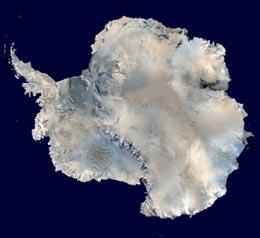Antarctica hit by climate change

In its landmark Fourth Assessment Report, the Intergovernmental Panel on
Climate Change (IPCC) declared in 2007 that human influence on climate "has
been detected in every continent except Antarctica". Now a paper in Nature
Geoscience says that our impact can be found even in the last wilderness1.
Didn't we already know that human activity was warming the Earth?
While some specific climate changes have been linked to human activity,
especially in the Arctic, it has not yet been possible to conclusively
demonstrate a link to actual surface temperature changes at both poles. When
they made their statement on Antarctica, the IPCC cited "insufficient
observational coverage to make an assessment".
"The scarcity of observations in the Antarctic makes it harder to
identify and attribute temperature trends, but it does not make it
impossible," says climatologist Nathan Gillett of Environment Canada, lead
author of the new study.
What did the researchers actually do?
Previous work has seen Antarctica temperature records ranging from 1900 to
the present day collated into one data set. Gillett and his colleagues
compared changes detailed in that data set with temperature changes
simulated in four different climate models, running the models both with and
without human influence factors.
Changes actually observed did not fit with the models when only natural
climate changes and variability were present. They were only explainable
when human influence on the climate was taken into account.
Why does it matter?
"Warming in both polar regions has many potential impacts - for example on
ice-sheet melting, sea level and on polar ecosystems," says Gillett, who
conducted the research while working at the University of East Anglia in
Norwich, UK.
Previous studies have not systematically compared temperature changes at the
poles with simulations running both with and without human influence, says
Gillett. His paper also focuses on specific locations and specific data
points, rather than a general trend over the poles.
"By this restriction, the group is able to perform an 'apples with apples'
comparison of model simulations and polar near-surface temperature records
during the twentieth century," write Andrew Monaghan of the National Center
for Atmospheric Research in Boulder, Colorado, and David Bromwich of Ohio
State University, Columbus, in a News and Views article accompanying the
paper2.
What happens now?
Gillett and his fellow author Alexey Karpechko of the University of East
Anglia are already working on a project to study future climate change in
Antarctica, incorporating the role of ozone and narrowing down the
uncertainties in current predictions.
Other researchers are working to integrate current knowledge of ice sheets
into the climate models used by people such as the IPCC. This will improve
our understanding of what is likely to happen to polar temperatures in the
future, potentially honing our current predictions to either something more
rosy, or something bleaker.
Monaghan says, "Considering the results of this study which shows the human
component is playing a big role, I would say it would lean towards being a
little bleaker."
*
References
1. Gillett, N. et al. Nature Geosci. doi:10.1038/ngeo338 (2008).
2. Monaghan, A. & Bromwich, D. Nature Geosci. doi:10.1038/ngeo346 (2008).
To subscribe or visit go to: http://www.nature.com